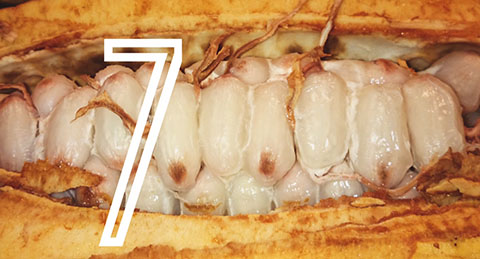Cacao’s deepest cultural history lies in its homeland, Mesoamerica and South America. Mesoamerica is where chocolate probably once reached its peak of culinary refinement and appreciation in the form of a frothy beverage. In The New Taste of Chocolate, Maricel E. Presilla shares this belief writing that the Mayan and Aztec chocolate “is not a dim historical footnote en route to real chocolate, meaning modern chocolate industrially processed for candies and cakes.” she goes on to say,
The first Mesoamerican discoverers of chocolate achieved the great feat of domesticating the plant and growing it in an ecologically sound way. They arrived at a sophisticated knowledge of chocolate’s culinary possibilities, combining it with a wide array of other ingredients–canilla, herbs, flower petals, chiles, maguey sap, honey, mamay sapote pits, and achiote–to create flavors and effects that make our uses for chocolate pale in comparison (9)
So while many people might think of the best modern chocolate in the form of a refined European dessert, Presilla is clearly arguing chocolate’s original refined form is a Mesoamerican thick, frothy beverage. She points to the Mayan culture as the great developers of chocolate knowledge. The Mayan culture experienced a golden age starting around 250 AD and continuing for 650 years. If you add to that another 200+ years that the Aztec culture had to develop recipes with cacao they took from south of their capitol city Tenochtitlan, its an incredible legacy of chocolate recipe development.
When chocolate was adopted by Europeans, it’s preparation, taste, even where and how it was grown began to change. Unfortunately the appreciation of chocolate’s inherent flavors seems to have decreased. Presilla writes that industrial chocolate “contained no extraneous flavors, yet paradoxically the basic chocolate flavor mattered less.”(40) In other words, there were no added spices or flower petals but the cocoa beans were poorly fermented, alkalized, over roasted, and diluted with sugar to the point that the beans themselves didn’t matter.
In the 21st century U.S. there is an exploding number of craft chocolate makers. While Lauren Adler and Clay Gordon both mentioned that lots of the new producers were making poor chocolate with nice wrappers, they also both said their are a lot of very good producers. At the NW chocolate festival we heard people talking about specific varieties of cacao (beyond the oversimplified inaccurate Criollo, Foresterro, and Trinatario groupings). We tasted chocolate from companies like Fresco that tell you on the bar where the beans are from, how darkly they are roasted and how long they are conched. This represents a new movement in U.S. chocolate culture. It’s a movement to learn how chocolate is made and appreciation of quality cacao beans.
